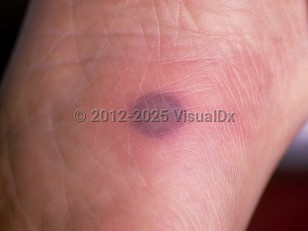Potentially life-threatening emergency
Disseminated Fusarium infection in Adult
Alerts and Notices
Important News & Links
Synopsis

Fusariosis is caused by Fusarium, a fungus that is ubiquitous in soil. It is the second most common mold infection behind aspergillosis, seen in immunocompromised patients with a life-threatening, disseminated infection. Skin infection is due to primary inoculation (more often seen in the immunocompetent) or due to dissemination (more often seen in the immunocompromised). Skin lesions, whether primary or disseminated, are present in more than 70% of patients with Fusarium infection.
Localized fusariosis presents as white superficial onychomycosis, intertrigo, tinea pedis, or cellulitis.
In disseminated fusariosis, the infection involves 2 or more noncontiguous sites, including the skin, lungs, eye, or other organs. The portal of entry may be the skin (in around a third of patients) especially via an indwelling venous catheter, or the respiratory or gastrointestinal (GI) tracts. There is often an abrupt onset of fever that can exceed 40°C (104°F) with malaise, chills, and myalgias. Skin lesions spread rapidly, involving the trunk and extremities. Sinopulmonary infection may also occur. Typically, patients have hematologic malignancies and immunosuppression, and Fusarium infection often follows bone marrow transplants. Only a few of all known cases involved patients who were not profoundly immunosuppressed. Epidemic iatrogenic cases have occurred. Chronic granulomatous disease can also predispose to Fusarium infection. The onset of disseminated Fusarium infection is generally a terminal event, with death occurring in 73% of reported cases.
Related topic: fungal corneal ulcer
Localized fusariosis presents as white superficial onychomycosis, intertrigo, tinea pedis, or cellulitis.
In disseminated fusariosis, the infection involves 2 or more noncontiguous sites, including the skin, lungs, eye, or other organs. The portal of entry may be the skin (in around a third of patients) especially via an indwelling venous catheter, or the respiratory or gastrointestinal (GI) tracts. There is often an abrupt onset of fever that can exceed 40°C (104°F) with malaise, chills, and myalgias. Skin lesions spread rapidly, involving the trunk and extremities. Sinopulmonary infection may also occur. Typically, patients have hematologic malignancies and immunosuppression, and Fusarium infection often follows bone marrow transplants. Only a few of all known cases involved patients who were not profoundly immunosuppressed. Epidemic iatrogenic cases have occurred. Chronic granulomatous disease can also predispose to Fusarium infection. The onset of disseminated Fusarium infection is generally a terminal event, with death occurring in 73% of reported cases.
Related topic: fungal corneal ulcer
Codes
ICD10CM:
B48.8 – Other specified mycoses
SNOMEDCT:
64250002 – Fusarium infection
B48.8 – Other specified mycoses
SNOMEDCT:
64250002 – Fusarium infection
Look For
Subscription Required
Diagnostic Pearls
Subscription Required
Differential Diagnosis & Pitfalls

To perform a comparison, select diagnoses from the classic differential
Subscription Required
Best Tests
Subscription Required
Management Pearls
Subscription Required
Therapy
Subscription Required
References
Subscription Required
Last Updated:03/06/2024
Potentially life-threatening emergency
Disseminated Fusarium infection in Adult

